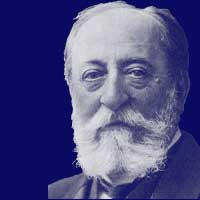Camille Saint-Saens - Biography
Camille Saint-Saens Biography
Charles Camille Saint-SaŽns (IPA: ʃaʁl.kamij.sɛ̃sɑ̃s) (October 9, 1835 – December 16, 1921) was a French composer and performer.
Saint-SaŽns was born in Paris. A child prodigy, two years after his birth he could already read and write and began piano lessons then almost immediately began composing. His first piano recital was at age five. At ten years of age he gave public recitals of Bach, Beethoven, and Mozart. At the age of sixteen, he wrote his first symphony.
In 1871 he co-founded the Sociťtť Nationale de Musique. He wrote dramatic works, including four symphonic poems, and 13 operas, of which Samson et Dalila and the symphonic poem Danse Macabre are among his most famous. In all, he composed over three hundred works and was the first major composer to write music specifically for the cinema.
In 1875, Saint-SaŽns married Marie Truffot and fathered two children who died within six weeks of each other in 1881. Saint-SaŽns left his wife the same year. The two never divorced, but lived the rest of their lives apart from one another. At that point he gives free rein to his love for young men. On being accused of homosexuality at a social occasion, he is reported to have countered 'Je ne suis pas homosexuel, je suis pťdťraste!'
In 1886 he wrote his Symphony No. 3, 'avec orgue', that is, 'with Organ', perhaps the most famous of all his works. Aided by monumental symphonic organs built in France by Mr. Aristide Cavaillť-Coll, at that time the world's greatest organ builder, this work in particular is immersed in the spirit of 'gigantism' of the dying XIX century, along with the Eiffel Tower, the Universal Exposition at Paris and the beginning of the 'belle epoque'. The Maestoso of the second movement is clearly an expression of the confidence of the European man in himself, in his technology, his science, his 'age of reason' (somewhat ironically, the melody was later used as the basis for the theme music of the immensely popular film Babe). He was frequently named as 'the most German composer of all the French composers', perhaps due to his fantastic skills exhibited in the construction of melodic passages.
Also in 1886, Saint-SaŽns completed The Carnival of the Animals, which was first performed on March 9th, 1886. Despite being very popular today, Saint-SaŽns forbade complete performances of it shortly after its premiŤre, only allowing one movement, 'The Swan', a piece for cello and piano, to be published in his lifetime.
Saint-SaŽns also wrote six preludes and fugues for organ, three in op. 99 and three in op. 109, the most performed of which is the Prelude and Fugue in E flat major, op. 99, no. 3.
Saint-SaŽns wrote on musical, scientific and historical topics, frequently travelling around Europe, North Africa, and South America. He chose to end his days in Algiers, Algeria, where he was able to freely indulge his tastes for young Arabs. In recognition of his accomplishments, the government of France awarded him the Legion of Honour.
Camille Saint-SaŽns died on December 16, 1921, in Algiers. His body was brought back to Paris for a state funeral and was buried in the CimetiŤre du Montparnasse, in Paris.
Selected works
- Op. 7 Rhapsodie for organ, from Three Rhapsodies on Breton Melodies
- Op. 28 Introduction et Rondo capriccioso pour violon et orchestre (1863)
- Op. 22 Concerto pour piano nį2 en sol mineur
- Op. 31 Le Rouet d'Omphale, poŤme symphonique (1869)
- Op. 33 Concerto pour violoncelle Nį1 en la mineur
- Op. 35 Transcriptions from Beethoven works: Eroica Variations
- Op. 40 Danse Macabre (1874)
- Op. 44 Concerto pour piano nį4 en ut mineur
- Op. 47 Samson et Dalila (opera) (1877)
- Op. 52 Six Etudes (1877)
- Op. 65 Septet for trumpet, string quintet and piano
- Op. 70 Allegro appassionato
- Op. 72 Album pour piano
- Op. 73 Rhapsodie d'Auvergne
- Op. 76 Wedding Cake, Caprice-Valse
- Op. 78 Symphony No. 3 avec orgue (1886)
- Op. 90 Fugue from the Suite for piano
- Op. 91 Chant saphique
- Op. 97 Theme Varie
- Op. 99 Preludes and Fugues for organ (1894) (includes Prelude and Fugue in E flat major, no. 3.)
- Op. 101 Fugatos from the organ works: Fantasia in D flat major for organ (1866)
- Op. 104 Valse mignonne
- Op. 109 Preludes and Fugues for organ (1898)
- Op. 111 Six Etudes pour le piano (1899)
- Op. 120 Valse langoureuse
- Op. 135 Six Etudes pour la main gauche seul (1912)
- Op. 139 Valse gaie
- Op. 161 Fugues for piano (1920)
- Op. none The Carnival of the Animals (Le Carnaval des animaux) (1886)
This biography is published under the GNU Licence

